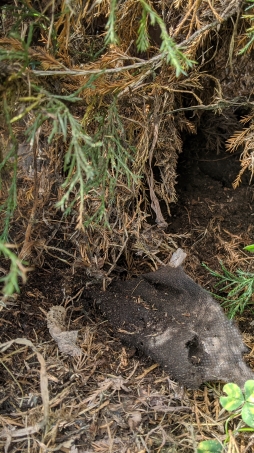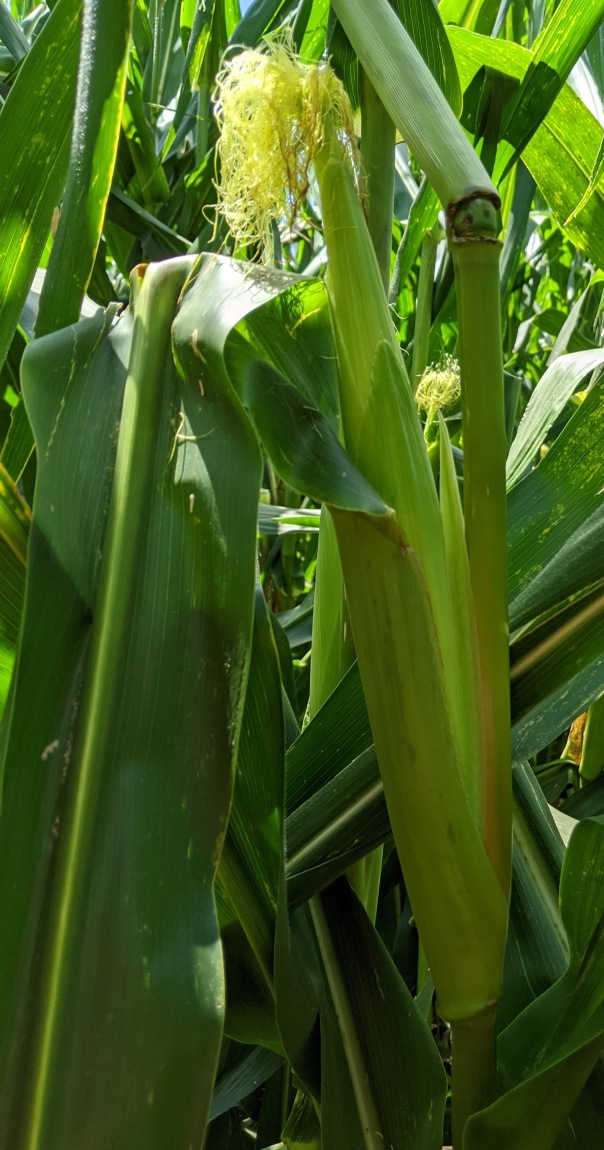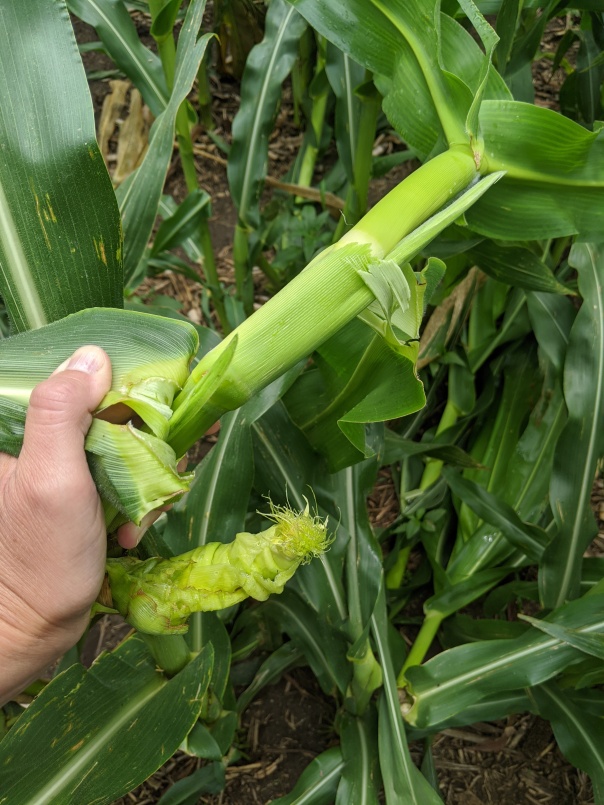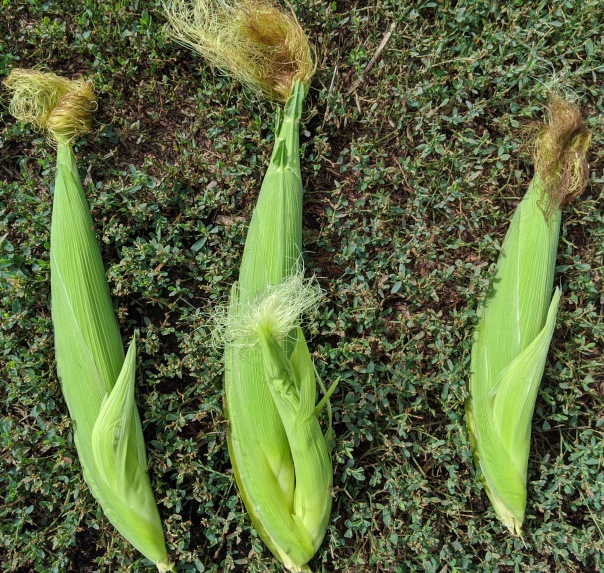| July-August Upcoming Events: July 28: Virtual youth crop scouting competition, Register: https://go.unl.edu/cropscoutingreg July 28: Free Webinar: Tomato Troubles, 7 p.m., Register: https://go.unl.edu/grobigredvirtual July 30: Free Webinar: Nebraska Farm Custom Rates Overview, 12 p.m., https://go.unl.edu/manage2020 Aug. 4: Free Webinar: Preserving the Harvest, 7 p.m., Register: https://go.unl.edu/grobigredvirtual Aug. 5-9: Seward County Fair Aug. 6-9: York County Fair Aug. 11: Free Webinar: Tree Problems, 7 p.m., Register: https://go.unl.edu/grobigredvirtual Aug. 18: Free Webinar: Herbs, 7 p.m., Register: https://go.unl.edu/grobigredvirtual Aug. 25: Free Webinar: Tree Selection, 7 p.m., Register: https://go.unl.edu/grobigredvirtual Aug. 28-Sept. 7: Nebraska State Fair |
Crop Update: Grateful to see how corn ears in wind damaged fields were able to expand and expose silks to pollen! Noticing on the primary ear node one normal ear and another 1-2 small ears on the same node in some hybrids-more common this year than I’ve noticed before. Unsure what to think of it; just an observation. Southern rust has been confirmed in 19 Nebraska counties at low incidence and severity; levels not necessary for fungicide applications yet (in my opinion). Last week I shared UNL data that showed no yield differences between a check treatment vs. various growth development timings (through 100% dent) and various fungicides in two low and moderate disease years. For those dealing with spidermites, it’s important to determine whether the plants have two-spotted or banks grass mites as they differ in control. For more information, check out this information: https://go.unl.edu/idsm.
Virtual Field Days: As someone who enjoys field days and meetings to see and catch up with people, it’s been hard to not have field days this year! Thankfully we can share information via technology. The following are resources for weed management and wheat production/variety info:
- South Central Ag Lab Weed Science Field Day: https://go.unl.edu/2020weedfieldday
- Glyphosate Resistant Palmer Amaranth Field Day: https://go.unl.edu/palmer-amaranth2020
- Wheat Field Days (Part 1 Production background): https://mediahub.unl.edu/media/13563
- Wheat Field Days (Part 2 Varieties): https://mediahub.unl.edu/media/13564
Tree Problems: Trees are important to any landscape, whether in town or on the farm!

Cedar tree in windbreak that suddenly died.
Often, there’s stories behind their planting and it’s always hard to see them decline/die. The #1 killer I’ve found of cedar windbreaks is landscape fabric used as a weed barrier when trees are planted. No matter what the product says or who tells you it will tear as the tree grows, it rarely does. It does a great job with weed control! And, 5-15 years down the road, it’s understandably forgotten. Once the tree trunk expands to where the original edge of the hole is, the trunk often can’t tear the fabric right at the soil line while the trunk above and below it tries to expand. Sometimes a tree can survive for awhile with the choking. However, if you ever see a tree that dies quickly with no other apparent reason, it usually

Landscape fabric I cut away from the tree. There was a clear indentation in the trunk where the tree was being choked (not pictured).
is due to something with the root system or choking somehow on the tree. In such cases, before the tree becomes a hazard to people or property, a professional tree removal service in Portland can help. I realize it’s a pain, but with as much work and money that goes into windbreaks, it’s a really good idea to take some time and pull weed barrier away from the tree trunks. A long-handled tool with tines can help but just make sure to carefully get all the way to the trunk to release any potential choking (I often have to get under the tree and cut the fabric next to the trunk to accomplish this). This goes for weed barrier used for any trees and shrubs. Weed barrier with rock is one of the biggest killers of plants I see in landscapes.
Bagworms are also impacting cedars, spruce, and various shrubs. Right now I recommend using Bifenthrin as it irritates the bagworms and makes them leave bags to be better exposed to the product. It has a two week residual and is used as an insecticide for many plant situations. Get really good coverage of the trees/plants when applying.
A number of fungal diseases are impacting evergreen trees. Many started the past few springs due to wet, humid weather. They are showing up worse now with recent humidity. The good news is trees can be treated with various fungicide products next spring that can be obtained from local hardware, farm, and landscape stores. PLEASE read and follow the label (can pull the label back in the store) regarding if the tree/plant is labeled for the product. I’ve been called out to disasters this year when the wrong products were applied to trees for which they weren’t labeled.
Japanese beetles continue to be a problem. Hopefully they’ll be finished in the next few weeks. Apply products at dusk to reduce harm to pollinators. Natural products include Neem and Pyola oil that can be applied every week. Conventional insecticides can provide 2 weeks of control: pyrethroid products like Tempo and Bayer Advanced Lawn & Garden Multi-Insect Killer (cyfluthrin) or Ortho Bug B Gone (bifenthrin).
York County Fair Open Class: Quick note for those exhibiting in York County Fair’s Open Class, we ask that you have entry tags completely filled out including mailing address PRIOR TO fair this year. Entry tags can be obtained from the York Co. Extension Office and Wagner Decorating. All rules same as last year except Needlework is limited to 3 entries per exhibitor. Exhibits can be dropped off on the WEST side of Ag Hall Tues. Aug. 4th from 6-8 p.m. and Wed. Aug. 5th from 8-11 a.m. Volunteers will take items into buildings as much as possible.

Ears able to elongate and expose silks to pollen on wind-damaged plants. Notice bent ear leaf that had been covering silks last week and bent node where plant was trying to right itself.

Second set of brace roots on leeward sides of plants now found the soil to support the plants with developing ears. Notice the emphasis placed on brace roots on that side instead of the windward side.

Seeing a lot of this. Pinched plants that bent at various angles to right themselves are fairly brittle and tend to snap as ears continue to develop and as one walks through fields.

The tertiary ear became the main ear on some bent plants. Notice the ear shoots of the primary and secondary ear (green things sticking out of nodes) on this plant and the messed up tertiary ear.

Hard to tell from this picture, but even the waterhemp righted itself in this field. This plant’s main stem actually goes to the left in the corn row but was pushed down under some broken corn so bent upright in the center of the row.

Have seen more of this for some reason this year. Solid ear with 1 or 2 additional ears on the primary ear node. Several hybrids across companies.


































